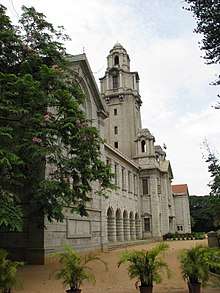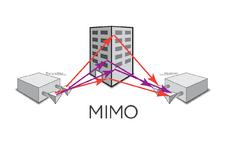Neelesh B. Mehta
| Neelesh B. Mehta | |
|---|---|
| Born |
January 9, 1975 India |
| Residence | Bengaluru, Karnataka, India |
| Nationality | Indian |
| Alma mater | |
| Known for | Studies on wireless networks |
| Awards |
|
| Scientific career | |
| Fields | |
| Institutions | |
| Doctoral advisor |
|
Neelesh B. Mehta (born January 9, 1975) is an Indian communications engineer, inventor and a professor at the Department of Electrical and Communications Engineering of the Indian Institute of Science. Known for his studies on wireless networks, Mehta is a holder of a number patents for his inventions. The Council of Scientific and Industrial Research, the apex agency of the Government of India for scientific research, awarded him the Shanti Swarup Bhatnagar Prize for Science and Technology, one of the highest Indian science awards, for his contributions to engineering sciences in 2017.[1][note 1]
Biography

Neelesh Mehtha was born on January 9, 1975.[2] It was during his school years that Mehta stood first in the Indian National Mathematical Olympiad at the state level in 1991 and the next year, he was selected for the National Talent Search Scholarship.[3] Joining the Indian Institute of Technology, Madras in 1992, on the strength of securing the second rank in the state and 17th in India in the engineering entrance examination, he earned a BTech in 1996, passing with the second rank in the institute.[4] He also received the Philips India Prize for performance excellence in electronics and communications engineering in IIT Madras. Moving to the US, he completed MS in engineering in 1997 from California Institute of Technology and won the AT&T World Leadership Award in the process.[5] He continued at the institution for his doctoral studies under the guidance of Andrea Goldsmith of Stanford University and after securing a PhD in electrical engineering in 2000, he started his career in 2001 as a research scientist at AT&T Labs.[6]
Mehta's stay in the US would last till 2007 during which period, he also worked with Broadcom (2002–03) and Mitsubishi Electric Research Laboratories (2003–07).[5] He returned to India in September 2007 to take up the position of an assistant professor at the Electrical Communication Engineering Department of the Indian Institute of Science where he is an associate professor since 2011.[7] He also heads the Next Generation Wireless Systems Lab where he hosts a number of research scholars and scientists who are engaged in research on various wireless communication modes.[8]
Mehta is a former member-at-large of the IEEE Communications Society (2014–15) and served as the director of corporate publications during 2012–13.[9] He has been associated with three of its journals, IEEE Transactions on Communications, IEEE Wireless Communication Letters and IEEE Transactions on Wireless Communications, serving as the executive editor of the last mentioned.[5]
Legacy

Mehta's research has been focused on energy harvesting wireless networks, interference modeling and co-operative communications,[10] with special focus on the design, invention, and performance analysis of various technologies.[7] He holds several patents for his inventions[11] which include Transmit power scaling method and system to detect occurrences using geographically distributed sensors,[12] Queued cooperative wireless networks configuration using rateless codes,[13] Antenna selection with frequency-hopped sounding reference signals[14] and Methods and systems for real-time monitoring of environments.[15] His studies have been documented by way of a number of articles[16][note 2] and ResearchGate, an online article repository of scientific articles, has listed 168 of them.[17] Besides, he has contributed chapters to several books edited by others.[18][19][20] He has also been involved in several projects undertaken by the Electronics and Communications Engineering department of IISc[3] and the invited talks delivered by him include Opportunistic Selection in Wireless Systems: Who, How, and What if of 2015 at Qualcomm, USA, Timer-Based Distributed Selection Schemes for Wireless Networks of 2013 Zhejiang University and Timer-Based Distributed Selection Schemes for Wireless Networks of 2012 at National University of Singapore.[21]
Awards and honors
Mehta received the Young Engineer Award of the Indian National Academy of Engineering in 2010.[22][note 3] The National Academy of Sciences, India elected him as a fellow in 2013;[23] a year later the academy would honor him again with the 2014 NASI-Scopus Young Scientist award.[5] The same year, the Department of Science and Technology selected him for the Swarnajayanti Fellowship, the tenure of the fellowship running until 2019.[24][note 4] He became an elected fellow of the Indian National Academy of Engineering in 2015 and a Featured Engineer of EE Times, the next year.[21] He received one more award in 2016 in the form of Hari Om Ashram Prerit Vikram Sarabhai Research Award of Physical Research Laboratory.[21] The Council of Scientific and Industrial Research awarded him the Shanti Swarup Bhatnagar Prize, one of the highest Indian science awards in 2017.[25]
Selected bibliography
Chapters
- Ekram Hossain, Vijay K. Bhargava, Gerhard P. Fettweis (Editors); Neelsh B. Mehta, Chandra R. Murthy (Chapter authors) (5 July 2012). "PHY and MAC Layer Optimization for Energy-harvesting Wireless Networks". Green Radio Communication Networks. Cambridge University Press. pp. 53–. ISBN 978-1-107-01754-2.
Articles
- Neelesh B. Mehta; Sarabjot Singh; Andreas F. Molisch (2010). "An Accurate Model for Interference from Spatially Distributed Shadowed Users in CDMA Uplinks". IEEE Xplore. doi:10.1109/GLOCOM.2009.5425277.
- Salil Kashyap; Neelesh B. Mehta (2013). "SEP-Optimal Transmit Power Policy for Peak Power and Interference Outage Probability Constrained Underlay Cognitive Radios". IEEE Transactions on Wireless Communications. 12 (12). doi:10.1109/TWC.2013.111013.130615.
- A. Karthik; Neelesh B. Mehta (2013). "En Masse Relay Selection Algorithms for Multi-Source, Multi-Relay, Decode-and-Forward Cooperative Systems". a. 61 (8). doi:10.1109/TCOMM.2013.070213.120839.
See also
Notes
References
- ↑ "View Bhatnagar Awardees". Shanti Swarup Bhatnagar Prize. 2017-11-11. Retrieved 2017-11-11.
- ↑ "Brief Profile of the Awardee". Shanti Swarup Bhatnagar Prize. 2017-10-21. Retrieved 2017-10-21.
- 1 2 "Biographical Information - Neelesh Mehta". Stanford University. 2017-11-09. Retrieved 2017-11-09.
- ↑ "INAE Experts - Neelesh B. Mehta". Indian National Academy of Engineers. 2017-11-09. Retrieved 2017-11-09.
- 1 2 3 4 "Neelesh B Mehta - Speaker Bio". StudyLib. 2017-11-09. Retrieved 2017-11-09.
- ↑ "Interview with Dr. Neelesh B. Mehta". EE Web. May 17, 2016. Retrieved 2017-11-09.
- 1 2 "Neelesh B Mehta - Faculty Profile". Indian Institute of Science. 2017-11-09. Retrieved 2017-11-09.
- ↑ "Next Generation Wireless Systems Lab-About us". Indian Institute of Science. 2017-11-09. Retrieved 2017-11-09.
- ↑ "Member-at-large" (PDF). IEEE Communications Society. 2017-11-09. Retrieved 2017-11-09.
- ↑ "Handbook of Shanti Swarup Bhatnagar Prize Winners" (PDF). Council of Scientific and Industrial Research. 2017-10-17. Retrieved 2017-10-17.
- ↑ "Patents by Inventor Neelesh B. Mehta". Justia Patents. 2017-11-09. Retrieved 2017-11-09.
- ↑ Neelesh Mehta (2017). "Transmit power scaling method and system to detect occurrences using geographically distributed sensors" (Patent No. 9749716). Justia Patents. US Patents. Retrieved 2017-11-09.
- ↑ Neelesh Mehta (2013). "Queued cooperative wireless networks configuration using rateless codes" (Patent No. 9083420). Justia Patents. US Patents. Retrieved 2017-11-09.
- ↑ Neelesh Mehta (2017). "Antenna selection with frequency-hopped sounding reference signals" (Patent No. 9025471). Justia Patents. US Patents. Retrieved 2017-11-09.
- ↑ Neelesh Mehta (2017). "Methods and systems for real-time monitoring of environments" (Patent No. 8823544). Justia Patents. US Patents. Retrieved 2017-11-09.
- ↑ "On Google Scholar". Google Scholar. 2017-11-09. Retrieved 2017-11-09.
- ↑ "On ResearchGate". On ResearchGate. 2017-11-09. Retrieved 2017-11-09.
- ↑ George Tsoulos (28 March 2006). MIMO System Technology for Wireless Communications. CRC Press. pp. 15–. ISBN 978-1-4200-0592-9.
- ↑ Ismail Guvenc; Sinan Gezici; Zafer Sahinoglu, Ulas C. Kozat (24 March 2011). Reliable Communications for Short-Range Wireless Systems. Cambridge University Press. pp. 11–. ISBN 978-1-139-50037-1.
- ↑ Ekram Hossain, Vijay K. Bhargava, Gerhard P. Fettweis (Editors); Neelsh B. Mehta, Chandra R. Murthy (Chapter authors) (5 July 2012). "PHY and MAC Layer Optimization for Energy-harvesting Wireless Networks". Green Radio Communication Networks. Cambridge University Press. pp. 53–. ISBN 978-1-107-01754-2.
- 1 2 3 "Neelesh B. Mehta on NGWSL". Indian Institute of Science. 2017-11-10. Retrieved 2017-11-10.
- ↑ "INAE Young Engineer Award". Indian National Academy of Engineering. 2017-11-10. Retrieved 2017-11-10.
- ↑ "NASI fellows". National Academy of Sciences, India. 2017-11-10. Retrieved 2017-11-10.
- ↑ "Swarna Jayanthi Fellowship". Department of Science and Technology. 2017-11-02. Retrieved 2017-11-02.
- ↑ "10 scientists receive Shanti Swarup Bhatnagar Prize". The Hindu. September 26, 2017. Retrieved 2017-11-11.
Further reading
- Neelesh B. Mehta (2017-11-09). "Energy Harvesting-Based Green Wireless Communication Systems" (Article (full text)). National Academy of Engineering. Retrieved 2017-11-09.
External links
- "List of Publications" (Author listing). dblp. 2017-11-08. Retrieved 2017-11-08.
- Andreas F. Molisch (6 February 2012). Wireless Communications. John Wiley & Sons. pp. 29–. ISBN 978-1-118-35568-8.